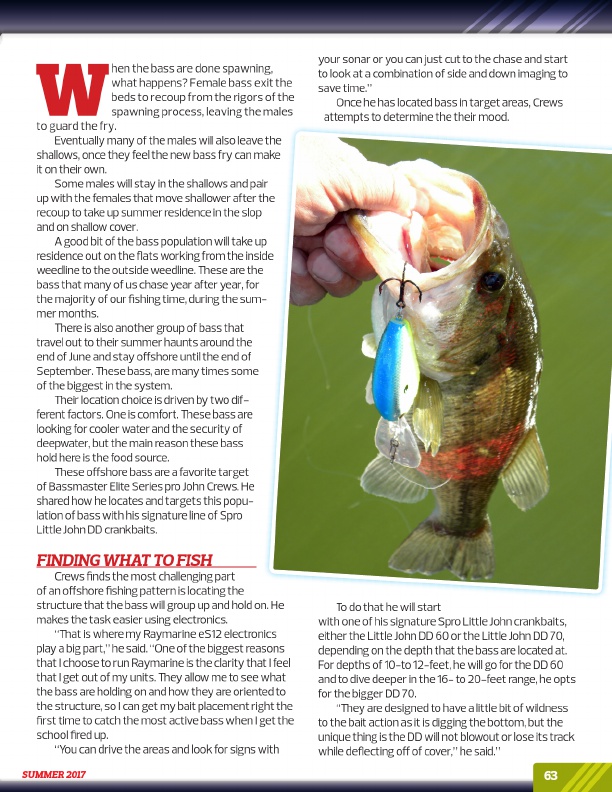
W
hen the bass are done spawning,
what happens? Female bass exit the
beds to recoup from the rigors of the
spawning process, leaving the males to guard the fry.
Eventually many of the males will also leave the
shallows, once they feel the new bass fry can make
it on their own.
Some males will stay in the shallows and pair
up with the females that move shallower after the
recoup to take up summer residence in the slop
and on shallow cover.
A good bit of the bass population will take up
residence out on the flats working from the inside
weedline to the outside weedline. These are the
bass that many of us chase year after year, for
the majority of our fishing time, during the sum-
mer months.
There is also another group of bass that
travel out to their summer haunts around the
end of June and stay offshore until the end of
September. These bass, are many times some
of the biggest in the system.
Their location choice is driven by two dif-
ferent factors. One is comfort. These bass are
looking for cooler water and the security of
deepwater, but the main reason these bass
hold here is the food source.
These offshore bass are a favorite target
of Bassmaster Elite Series pro John Crews. He
shared how he locates and targets this popu-
lation of bass with his signature line of Spro
Little John DD crankbaits.
FINDING WHAT TO FISH
Crews finds the most challenging part of an offshore fishing pattern is locating the structure that the bass will group up and hold on. He makes the task easier using electronics.
“That is where my Raymarine eS12 electronics play a big part,” he said. “One of the biggest reasons that I choose to run Raymarine is the clarity that I feel that I get out of my units. They allow me to see what the bass are holding on and how they are oriented to the structure, so I can get my bait placement right the first time to catch the most active bass when I get the school fired up.
“You can drive the areas and look for signs with
SUMMER 2017
your sonar or you can just cut to the chase and start to look at a combination of side and down imaging to save time.”
Once he has located bass in target areas, Crews attempts to determine the their mood.
To do that he will start with one of his signature Spro Little John crankbaits, either the Little John DD 60 or the Little John DD 70, depending on the depth that the bass are located at. For depths of 10-to 12-feet, he will go for the DD 60 and to dive deeper in the 16- to 20-feet range, he opts for the bigger DD 70.
“They are designed to have a little bit of wildness to the bait action as it is digging the bottom, but the unique thing is the DD will not blowout or lose its track while deflecting off of cover,” he said.”
63